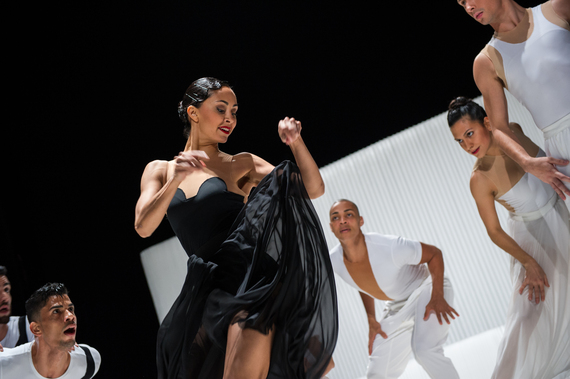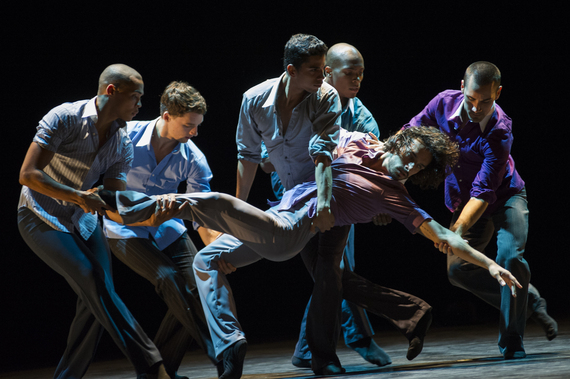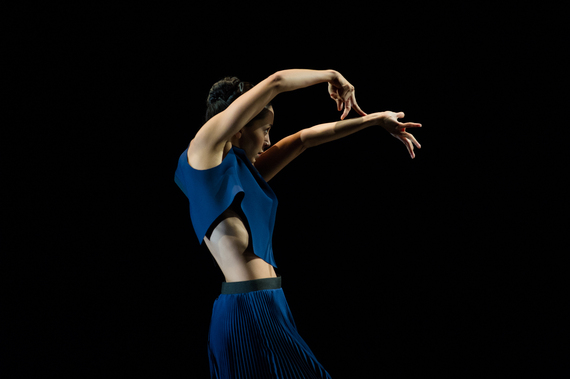Photo credit: Paula Lobo
"What is the experience of a Latin artist out in the desert, isolated? What does he bring to the table?"
Shifting forward in his chair, Eduardo Vilaro responds to questions with more quandaries while his mouth curves upward on one side with the kind of intentness that signals engagement and interest. As a curator of dance, he doesn't have all the answers, but he does have a critical eye for who merits a platform beyond the popularity of Ohad Naharin or Jiří Kylián. He sets his choreographers free by boxing them into a studio with Ballet Hispanico's dancers, who are a force to be reckoned with thanks to their power and eagerness. They respond to questions with their bodies when words won't suffice.
However, Miguel Mancillas, a "Latin artist out in the desert, isolated," comes up with the most eloquent words that suit his sensibility for motion. A man of Mexico, Mancillas zoomed into Vilaro's view when the latter saw one of his works in Chicago years ago. Now, as artistic director of Ballet Hispanico, Vilaro decides whose input is most worth recognizing in concert halls. This season at the Joyce Theater, Mancillas was one of the artists who made the cut.
Quiet and brooding, Mancillas appears Vilaro's antithesis. There's something hauntingly majestic about the lilt in his voice and his relaxed nature as he decries the arbitrariness of humanity. He seems wise with his silver mane and somehow sly like a fox who's also brutally honest. His opinions are tortured, nearing nihilistic, but he says them so sweetly that they go down like medicine with a spoonful of sugar.
Mancillas' commission reflects his complex aura. Entitled Conquer, it's a narrative about migration. "You move to another country for example, or you move from your person to another person, and you change everything," he explained. "Everything moves."
But why do we move? Why is there this perpetual desire for something unattainably extraordinary, and why must we sacrifice our own contentedness to never arrive at this unreachable wonderland?
"We are really weak as a species, and we are always looking for a better place," he continued. "We protect ourselves. We have a lot of fears, so that's why we're always looking for a better situation. Better money to be okay, better couple to feel like everything is fine, like you have control in your comfort. And I feel like we get obsessed with that."
But in the end, running faster and farther won't help you find salvation because it's impossible to escape yourself. "It's not the city, it's you," Mancillas said. "The city's inside you. It's not about the place you are (in), it's about who you are."
For Mancillas, his work gives him a venue to explore his questions, to weave them together through experience. Dance is art, after all, and so it can communicate subjective truths that transcend the everyday. It's like any other vehicle that allows you to peer into another reality, to be a voyeur with a purpose for a few indulgent minutes.
"When I go to a museum, I can see everything there, and for me that's amazing," Mancillas said. "When I read a book and I can go, and feel, and understand something else, for me that's amazing because I don't have to really live everything. I can live through something."
For Vilaro, that "something" is conversation. But not necessarily with vocal cords working overtime as lips form syllables and syntax falls into a pretty rhythm. No, he's looking for "something" a little rawer than that -- the soul expressed through the body to beats that reflect a distinct perspective. Or really, he's looking for a physical discourse on community.
"We don't have enough dialogue about race," Vilaro said. "We don't have enough dialogue about culture. And so that is the beauty of this art form and this organization: that it can do that on a very safe level."
But safety doesn't imply lack of daring. As a choreographer himself who aims to put the criollo on the stage, Vilaro wouldn't invite a colleague to set a rep on his company if he didn't believe that the voice would fuel discussion.
"I look for people who are interested in taking the culture and questioning it, glorifying it, making fun of it, poking holes through it," he explained. "I'm looking for Latino choreographers that want to go beyond the folkloric form but not negate it, either."
Indeed, so much of the Latino identity is wrapped up in this enigmatic folklore, whether because of internal connection or external projection. Especially in dance, the sensuous siren and masculine matador are archetypes for Hispanic characters. Think West Side Story, or Spanish in The Nutcracker, or some of Mark Morris' more exotic creations. Hispanic, Latino, and Chicano singularities have been co-opted for sex appeal among the dancing elite because Spain and its former colonies harbor the allure of "mestizaje," a constant intertwining of peoples and places through blood and being.
Photo credit: Paula Lobo
The problem with this intoxication is that Jerome Robbins' Latino identity doesn't necessarily reflect the genuine sentiments of the Hispanic race. It's entertaining, sure, but it's also constructed by someone who doesn't understand the very thing he's evoking.
"That European imperialism can overtake us, and so it's my job to really question that," Vilaro claimed. "We have to show this because we're not always happy people to happy music, and that is a very colonialist mentality that 'I want to come see Latin dance and it's got to be like this.' I have to challenge that, so I have to challenge my audiences, and I love that. I think it's exciting."
That said, it's important to recognize that ballet itself stems from palaces, princes, and princesses and is a manifestation of monarchy and feudalism inherent to Europe. "We can't get away from our lineage of the court dances," Vilaro continued, "but we certainly can comment on it."
As a dancer with Ballet Hispanico, Vilaro could count the number of Hispanic choreographers he collaborated with over a decade on his hand. When he was appointed artistic director in 2009, one of his main objectives was to change that. It is "Ballet Hispanico," after all. The name should mean more than a captivating title on a billboard.
Some dance aficionados have declared Vilaro's stint as artistic director to be Ballet Hispanico's "dark phase," a phrase that Vilaro doesn't take to kindly. "Do you realize what you've just said?" he asked of the critics. "Yes, we're dark, too. We are dark. We're dark in skin, as well as light. We're dark in humor, realism, the darkness that is in Spanish culture, that is dark comedy."
Still, in the end, Ballet Hispanico searches for universality. The troupe is diverse to reflect "who we are as hybrids in the world." Pieces like Mancillas' are about what it means to be mortal and flawed, not what it's like to come from a specific race or ethnicity. The world isn't cookie cutter, and neither is Vilaro's company.


